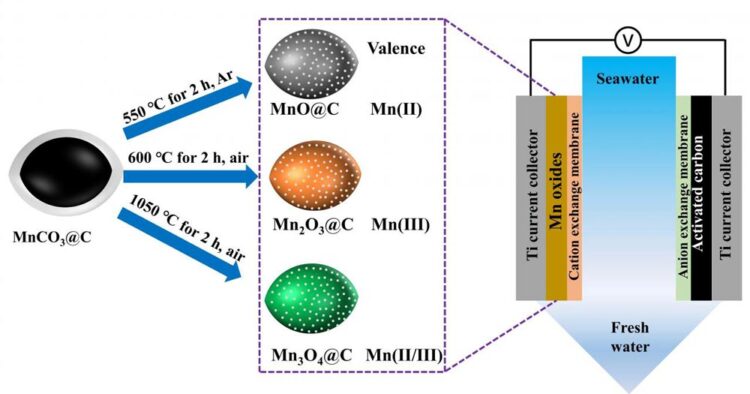High-capacity electrodes by valence engineering developed for desalination

Schematic diagram of MnOx@C electrode preparation and asymmetric membrane CDI device assembly.
Credit: XU Yingsheng
Recently, the researchers from Institute of Solid State Physics, Hefei Institutes of Physical Science (HFIPS) of the Chinese Academy of Sciences, by using valence engineering, developed three manganese oxides as electrodes with different Mn valences for high-performance capacitive desalination.
Reverse osmosis and thermal distillation are widely used to treat salt water with high salt concentration, but they have disadvantages including high energy consumption and high cost.
As an alternative method, capacitive deionization (CDI) technology can remove charged ions from desalt water through electrosorption or pseudocapacitive reaction. However, there are few reports on manganese oxides with lower valence of Mn, compared with the number of reports on MnO2. Hence, whether there is a difference in desalination performance in such different valence states of Mn and the internal reasons are worth exploring.
In this study, because of the high-capacity characteristic of the Faradic electrode, the researchers prepared three different manganese oxide carbon compositions with different valence states of Mn by calcining MnCO3@C precursor under different atmospheres and temperatures, and they combined them with commercial activated carbon electrode to assemble an asymmetric CDI unit. All as-prepared manganese oxides maintained the spindle-like morphology of the precursor.
The results showed that manganese oxides with divalent, trivalent and divalent/trivalent all displayed high salt adsorption capacity and corresponding high salt adsorption rates in 500 mg L-1 NaCl solution, surpassing other advanced carbon materials. Among them, MnO@C indicated the best electrosorption performance and Mn3O4@C has the worst.
The density functional theory (DFT) calculation results proved that the valence state of manganese during Na+ absorption could bring distinct discrepancy in the spatial structure and absorption capacity. Therefore, the researchers concluded that in terms of capacity and stability, the manganese oxides with divalent (MnO@C) was more suitable than trivalent (Mn2O3@C) and divalent/trivalent (Mn3O4@C) manganese oxides for CDI desalination.
The valence engineering provides a novel way for preparing high-performance pseudocapacitive materials for capacitive desalination.
Media Contact
All latest news from the category: Physics and Astronomy
This area deals with the fundamental laws and building blocks of nature and how they interact, the properties and the behavior of matter, and research into space and time and their structures.
innovations-report provides in-depth reports and articles on subjects such as astrophysics, laser technologies, nuclear, quantum, particle and solid-state physics, nanotechnologies, planetary research and findings (Mars, Venus) and developments related to the Hubble Telescope.
Newest articles

First-of-its-kind study uses remote sensing to monitor plastic debris in rivers and lakes
Remote sensing creates a cost-effective solution to monitoring plastic pollution. A first-of-its-kind study from researchers at the University of Minnesota Twin Cities shows how remote sensing can help monitor and…

Laser-based artificial neuron mimics nerve cell functions at lightning speed
With a processing speed a billion times faster than nature, chip-based laser neuron could help advance AI tasks such as pattern recognition and sequence prediction. Researchers have developed a laser-based…

Optimising the processing of plastic waste
Just one look in the yellow bin reveals a colourful jumble of different types of plastic. However, the purer and more uniform plastic waste is, the easier it is to…


